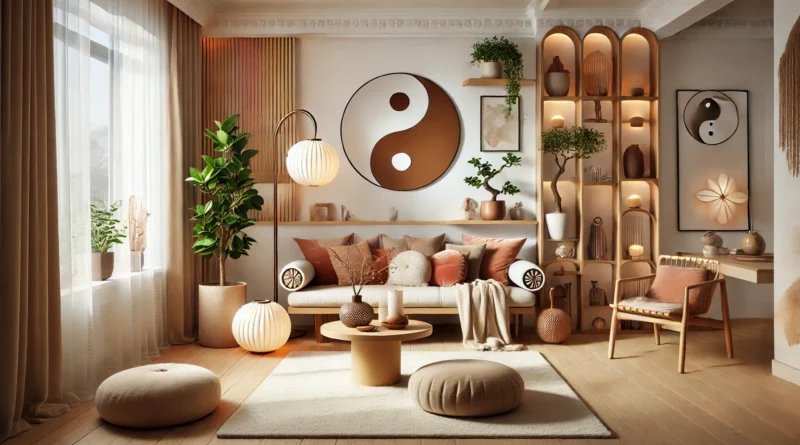How to Use Feng Shui to Balance Yin and Yang Energy at Home
In Feng Shui, Yin and Yang represent the essential balance of all energies in life. Yin is calming, nurturing, and introspective. Yang is active, bright, and energizing. A home that feels too heavy in one direction—too passive or too chaotic—can leave you feeling drained or overwhelmed. The goal is harmony: a space that supports both rest and action, softness and strength.
Let’s explore how to use Feng Shui to balance Yin and Yang energy in your home, creating an environment that feels alive, yet grounded.
1. Understand the Basics of Yin and Yang Energy
Before adjusting your space, it’s helpful to recognize the qualities of each energy:
- Yin: dark, soft, cool, slow, curved, muted, restful
- Yang: bright, loud, warm, fast, angular, stimulating, energetic
Your ideal home includes both. Too much Yin? You may feel sleepy or uninspired. Too much Yang? You may feel anxious or restless.
2. Observe the Existing Energy in Your Space
Walk through your home and notice:
- Are there areas that feel too dim, quiet, or heavy? (Yin excess)
- Are there rooms that feel overstimulating or busy? (Yang excess)
- Pay attention to lighting, color, sound, and clutter
- Adjust based on what’s lacking to move toward balance
Observation is your first Feng Shui tool.
3. Use Lighting to Balance Energies
Lighting is one of the quickest ways to adjust Yin and Yang.
- Bright, natural or white light adds Yang energy
- Soft, warm, or dim light increases Yin energy
- In active spaces (kitchen, office), prioritize Yang brightness
- In restful spaces (bedroom, reading nook), use Yin lighting like lamps or candles
Layer lighting so you can adapt to different needs throughout the day.
4. Balance Color Palettes
Colors carry distinct Yin or Yang qualities.
- Yang colors: red, orange, yellow, bright white
- Yin colors: blue, green, black, gray, soft pastels
- Balance bright accent colors with neutral, calming tones
- Use Yang in lively areas (kitchen, workspace) and Yin in restful zones (bedroom, meditation space)
A harmonious palette sets the mood of your entire home.
5. Mix Textures for Sensory Balance
Texture creates energetic texture too.
- Yin textures: velvet, silk, soft wool, plush rugs
- Yang textures: glass, metal, crisp linen, polished wood
- Combine soft furnishings with structured elements
- In bedrooms or cozy corners, emphasize Yin comfort; in offices, boost Yang clarity
Let your fingers feel the balance of energy.
6. Balance Shapes and Forms
The form of your furniture and decor affects flow.
- Yang shapes: sharp, angular, geometric
- Yin shapes: round, curved, organic
- Soften sharp corners with rounded objects nearby
- Blend both to ensure energy flows without feeling chaotic or stagnant
Visual balance supports emotional balance.
7. Incorporate Both Active and Passive Sounds
Sound plays a subtle but powerful role in energy.
- Yang sounds: lively music, laughter, chimes
- Yin sounds: soft ambient music, nature sounds, silence
- Use energetic playlists while cleaning or working
- Transition to calming sounds in the evening for balance
Let sound guide your home’s rhythm.
8. Use Plants to Harmonize Yin and Yang
Plants balance life force in any space.
- Yang plants: upright, bold-leafed plants (e.g., rubber plant, fiddle leaf fig)
- Yin plants: flowing, soft-leafed plants (e.g., pothos, ferns)
- Blend both types for visual and energetic harmony
- Keep plants healthy—dying plants drag down energy
Living greenery balances stillness and vitality.
9. Balance Activity Zones and Rest Zones
Your home should support both action and restoration.
- Ensure your office, kitchen, and workout areas are energized but not chaotic
- Create cozy, Yin-heavy spaces for reading, meditation, or relaxation
- Avoid too much activity in rest areas and vice versa
- Let each room support its purpose energetically
Purposeful spaces create purposeful energy.
10. Adjust Energy With Seasonal Shifts
Seasons naturally influence Yin and Yang balance.
- Summer (Yang): embrace lighter fabrics, vibrant colors, open windows
- Winter (Yin): use warm textiles, soft lighting, deeper hues
- Refresh your decor seasonally to stay in tune with nature
- Let the changes in your environment mirror natural cycles
Seasonal awareness keeps your home aligned.
11. Incorporate Personal Rituals for Balance
Daily habits help harmonize internal and external energy.
- Start your day with Yang energy: open windows, stretch, play music
- Wind down with Yin energy: dim lights, light candles, journal
- Use intentional rituals to move between states throughout your day
- Let your space respond to your needs, moment by moment
Energy responds to rhythm.
12. Reflect and Rebalance Regularly
Energy shifts as life does.
- Monthly, walk through your home and check for imbalance
- Adjust lighting, color, sound, or layout as needed
- Stay responsive—there’s no permanent “perfect” setup
- Trust your instincts: your body knows what balance feels like
Feng Shui is a living practice, not a static rule.
Final Thoughts: Create Dynamic Harmony at Home
Life is a dance between Yin and Yang. When your home reflects this natural balance, you feel both energized and grounded, focused and at peace. Feng Shui teaches us to flow with life’s rhythms, not resist them.
Let your home be a mirror of dynamic harmony—a space where every mood, every moment, and every day feels aligned.
